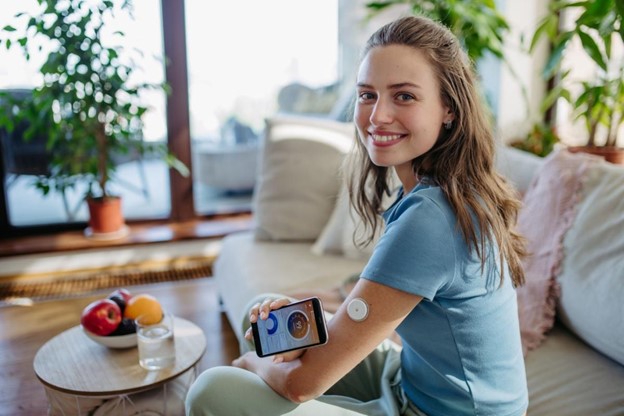Living with diabetes requires constant vigilance, especially when it comes to managing your blood sugar levels. The stakes are high, but so is the potential for a healthy, vibrant life with the right tools at your disposal. Enter Continuous Glucose Monitoring (CGM), a game-changing technology that allows you to keep a close eye on your glucose levels around the clock.
Along with treating diabetes, the practices in the Nirvana Healthcare Network believe in empowering our patients with the information and tools they need to control their blood glucose levels. Let’s delve into everything you need to know about Continuous Glucose Monitoring, from how it works to who can benefit most. Contact your care team for more about this revolutionary diabetes technology or our renowned primary care services!
What Does Continuous Glucose Monitoring Mean?
CGM is a non-invasive method of monitoring blood glucose levels throughout the day and night. Unlike traditional blood glucose monitoring methods that require finger pricks, CGM uses a small sensor inserted under the skin to continuously measure glucose levels in the interstitial fluid.
So, how does a continuous glucose monitor work? The CGM system consists of a sensor, a transmitter, and a receiver. The sensor measures glucose levels and transmits the data to the receiver, which displays the readings on a screen or sends them to a smartphone or other compatible device.
Benefits of Having a Continuous Glucose Monitor
Continuous glucose monitors offer numerous advantages over traditional blood glucose testing methods, allowing individuals to take a more proactive approach to managing their diabetes. By providing a constant stream of blood glucose readings, CGM helps users make informed decisions about their treatment and lifestyle choices. Additional benefits include:
- Real-time monitoring: Continuous glucose monitors provide real-time glucose data, allowing for immediate changes to diet, exercise, or medication.
- Reduced finger pricks: With continuous glucose monitors, the need for frequent finger pricks is significantly reduced, making diabetes management less painful and invasive.
- Improved glucose management: Continuous glucose monitoring helps users and healthcare providers track trends in glucose levels, leading to better overall glucose management.
- Early detection of fluctuations: Continuous glucose monitors alert users to changes in glucose levels before they become problematic, helping to prevent episodes of low blood sugar or high blood glucose.
Who Should Consider Using CGM?
While continuous glucose monitoring can benefit many individuals with diabetes, certain groups may find it particularly pragmatic. Below, we explore the specific groups of people who should consider this device.
Type 1 Diabetes Patients
Type 1 diabetes is an autoimmune condition that destroys insulin-producing cells in the pancreas. CGM can be particularly helpful for individuals with type 1 diabetes as it allows them to closely monitor their blood sugar levels and adjust how much insulin they need.
Type 2 Diabetes Patients
While not all Type 2 diabetes patients require continuous glucose monitoring, those who use an insulin pump or have difficulty controlling their blood sugar levels can benefit greatly from this technology. For Type 2 diabetes patients struggling with frequent hypoglycemia or those aiming to improve their overall glucose control, CGM can provide the necessary data to fine-tune their management strategies and achieve better outcomes.
Pregnant Women With Gestational Diabetes
Gestational diabetes can pose significant risks to both mother and baby if not properly managed. Continuous glucose monitoring can help pregnant women with gestational diabetes maintain optimal blood glucose levels throughout their pregnancy. By using a continuous glucose monitor, these women can monitor their glucose levels more closely, helping to prevent complications such as low blood glucose or the development of diabetes in the future.
Types of Continuous Glucose Monitoring Systems
There are two primary types of continuous glucose monitoring systems: professional CGM and personal CGM. Each offers unique benefits depending on the user’s needs and the healthcare setting.
Professional CGM
Professional CGM systems are typically used for short-term diagnostic purposes under the supervision of healthcare providers. These systems are worn by patients for a specific period, usually 3 to 14 days, to gather comprehensive glucose data. During this time, the device records glucose levels without displaying real-time information to the patient. After the monitoring period, the healthcare provider analyzes the collected data to identify patterns, trends, and areas for improvement in the patient’s diabetes management plan. Professional CGM is particularly useful for patients who are newly diagnosed, considering changes to their treatment regimen, or experiencing unexplained glucose fluctuations.
Personal CGM
Personal CGM systems are designed for long-term, daily use by individuals managing their diabetes. These devices provide real-time glucose readings and alerts directly to the user, enabling immediate action and decision-making. Personal CGM systems typically consist of a sensor worn on the body, a transmitter that sends data wirelessly, and a receiver or compatible smart device for displaying glucose information. Many modern personal CGM systems integrate with insulin pumps, creating a closed-loop system that can automatically adjust insulin delivery based on glucose readings.
Potential Challenges & Considerations
While continuous glucose monitoring offers numerous benefits, it’s important to consider potential challenges and limitations. The accuracy of CGM systems has improved significantly over the years, but readings can sometimes differ from traditional blood glucose measurements. Users should be prepared to perform occasional finger prick tests to calibrate the device and verify readings, especially when making critical treatment decisions. Some individuals may experience skin irritation or discomfort at the sensor insertion site, though this is generally minimal with proper care and rotation of insertion sites.
Learn More About CGM & How We Can Help
Continuous glucose monitoring has revolutionized diabetes management, offering real-time insights and better control over glucose levels. At Nirvana Healthcare Network, our dedicated team is here to help you navigate the complexities of diabetes technology, including continuous glucose monitors, and develop a treatment plan that suits your unique needs. If you’re interested in learning more about how continuous glucose monitoring can benefit you, contact our team to schedule a consultation.

